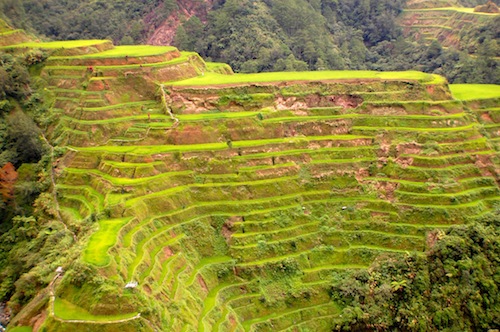Soaring to great heights, the Ifugao Rice Terraces is touted to be a masterpiece of the ingenuity of the highland people in Northern Philippines for generations. Its beauty, magnitude, people and history is truly breathtaking. But up to this day, questions remain on how old the Ifugao Rice Terraces really is?
For so many years, local and foreign anthropologists, archaeologists and historians continue to provoke interest and imagination to the origin and age of the rice terraces.
Textbooks and national histories have long been carrying the findings of American anthropologists Roy F. Burton and Henry Otley Beyer putting the age of the rice terraces to be 2,000 or 3,000 years old. Other scholars have argued that the existence of the rice terraces might be 300 years old or as late as the arrival of the Spanish in the Philippine lowlands.
But according to the latest findings of the Ifugao Archaeological Project led by Filipino archaeologist Stephen Acabado, the Ifugao Rice Terraces were built circa 1500 to 1600 AD, making it 400 to 500 years old only.
“ It’s a great mystery. The debates on the actual age of the rice terraces are still intense because of the implications that are attached to the antiquity of the rice terraces such as its history, tourism, among others,” Acabado told the Philippine EnviroNews, who presented his group’s initial findings at the University of the Philippines Baguio last week.
Acabado said his group excavated on the site of the Old Kiyyangan Village in Ifugao using the Bulk Soil Radiocarbon Dates and the Bayesian approach or tools to determine the antiquity and age of events.
Acabado said that by using digitized land use maps and ethnographic data on rice terracing practices in Ifugao, they identified the Bocos terrace system in Banaue as the oldest terraces. Excavations were conducted there to obtain charcoal samples for radiocarbon determinations.
In their study, Acabado said that the dating of the Ifugao agricultural terraces provides several contributions to the Philippine and Southeast Asian. First, he argued, the Bayesian model offers an approach to date other agricultural terrace system in the Cordillera and the rest of Southeast Asia. Second, the radiocarbon determinations and subsequent calibrations from the Bocos agricultural terraces suggests that the suite of agricultural strategies of ancient Filipinos include terracing.
“ Indeed, terraces can be seen across the Philippine archipelago – not as magnificent as what we see in the Cordilleras, but illustrates similar technology,” he added.
He said that based on their findings, the extent of the rice terraces that we see today could be a product of historical population movements in between 1500-1600 AD.
“If the initial terrace expansion coincides with the arrival of the Spanish in the Northern Luzon lowlands in AD 1585, this correlation may suggest that indigenous population migration away from the Spanish invasion and into the highland was significant enough to expand terrace systems,” their study indicated.
Acabado argued that earlier studies on the actual age of the rice terraces in Ifugao “lack systematic archaeological data”.
Their project is a collaboration among the National Museum of the Philippines, Save the Ifugao Terraces Movement (SITMO), the Cordillera Studies Center- University of the Philippines-Baguio, Archaeological Studies Program University of the Philippines-Diliman, the University of Guam and the local government of Ifugao.
What matters most?
Acabado, however, said that the aim of their archaeological works in Ifugao also aim to promote the idea that an older or later dating does not diminish the heritage value of the Ifugao rice terraces.
“ The rice terraces symbolizes the rich culture of Filipinos. Rehabilitation and restoration efforts of the people in Ifugao and the Philippine government are much needed in order to preserve its integrity and survival,” Acabado stressed.
In 1995, the United Nations Educational, Scientific and Cultural Organization (UNESCO) inscribed five clusters of the Rice Terraces to its World Heritage List: those of Batad and Bangaan (in Banaue), Nagacadan (in Kiangan), Hungduan, and Mayoyao.
For Marlon Martin, Chief Operating Officer of the Save the Ifugao Terraces Movement (SITMO), the actual age of the rice terraces does not matter to the people of Ifugao.
“ We hope that this latest archaeological finding would boost our campaign to integrate cultural heritage and indigenous knowledge at the heart of formal education systems,” Martin said.
He lamented that indigenous knowledge transfer is ever important as “most of the elders are now dying or too old to teach.”
Also at present, environmental degradation and neglect, largely brought about by modern life and changing values of Ifugao’s young generation, have robbed this natural wonder of its exotic beauty. Already, sections of the terraces have worn away, with jagged earth now showing where green rice stalks once swayed.
“It’s also a challenge for us to restore, rehabilitate and maintain the beauty of our heritage. Some people also abandoned the terraces in favor of more lucrative livelihood opportunities in big cities,” Martin said.
According to the belief of most of the Ifugaos, god gave them the rice terraces, which enabled them to live and grow food in a harsh environment.
“ Whatever the age of the rice terraces is, it is still a testimony to the splendor of the ancient cultural landscape and the rich culture of the people,” Martin said.
Photos by PNEJ member, Imelda V. Abano.

